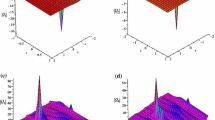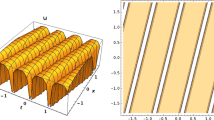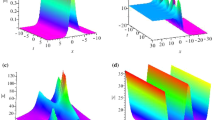Abstract
In this paper, we establish exact soliton solutions for the Davey–Stewartson equation. The trial equation method and the ansatz approach are used to construct exact 1-soliton solutions of this equation. We apply the trial equation method to establish solitary waves soliton, dark soliton and singular solitary waves soliton solutions. The Davey–Stewartson equation is the well-known example of integrable equations in two space dimensions, which arise as higher-dimensional generalizations of the nonlinear Schrödinger equation.
Similar content being viewed by others
Explore related subjects
Discover the latest articles, news and stories from top researchers in related subjects.Avoid common mistakes on your manuscript.
1 Introduction
Nonlinear partial differential equations (PDEs) are encountered in various disciplines, such as physics, mechanics, chemistry, biology, mathematics and engineering [1–34]. The study of exact solutions of these equations plays a major role in the study of the propagation of waves. With the development of soliton theory, many useful methods for obtaining exact solutions of nonlinear PDEs have been presented. Some of them are: ansatz method [1–5], tanh method [6, 7], multiple exp-function method [8], transformed rational function method [9], first integral method [10], simplest equation method [11, 12], Kudryashov method [13, 14], modified simple equation method [15] and so on.
One of the most effective direct methods to develop the traveling wave solution of nonlinear PDEs is the trial equation method [16]. The most complete description of this method was given in [17]. This method has been successfully applied to obtain exact solutions for a variety of nonlinear PDEs [17–19].
In this paper, we consider the Davey–Stewartson (DS) equation [20–28]
The parameter \(\lambda \) characterizes the focusing or defocusing case. The Davey–Stewartson equation is the well-known example of integrable equations in two space dimensions, which arise as higher-dimensional generalizations of the nonlinear Schrödinger equation (NLSE) [20].
The nonlinear Schrödinger’s equation describes numerous nonlinear physical phenomena in the field of applied sciences such as solitons in nonlinear optical fibers, solitons in the mean-field theory of Bose-Einstein condensates, rogue waves in oceanography.
Davey and Stewartson first derived their model in the context of water waves, from purely physical considerations. In the context, q(x, y, t) is the amplitude of a surface wave packet, while \(\phi (x,y,t)\) represents the velocity potential of the mean flow interacting with the surface wave [20].
The Davey–Stewartson equations are also reduced to Hamiltonian ODEs [23], and so exact solutions could be furnished by the integrability [24] of finite-dimensional Hamiltonian systems.
The aim of this paper is to find exact solutions of the Davey–Stewartson equation by the trial equation method and the ansatz approach.
2 Trial equation method
In this section, we outline the main steps of the trial equation method [16–19] as following
Step 1. Suppose a nonlinear PDE
can be converted to an ordinary differential equation (ODE)
using a traveling wave variable \(u(x,t)=U(\tau ),~~\tau =x-vt\), where \(U=U(\tau )\) is an unknown function, Q is a polynomial in the variable U and its derivatives. If all terms contain derivatives, then Eq. (3) is integrated where integration constants are considered zeros.
Step 2. Take the trial equation
where \(a_{l}, (l=0,1,...,N)\) are constants to be determined. Substituting Eq. (4) and other derivative terms such as \(U''\) or \(U'''\) in Eq. (3) yields a polynomial G(U) of U . According to the balance principle, we can determine the value of N . Setting the coefficients of G(U) to zero, we get a system of algebraic equations. Solving this system, we shall determine v and values of \({a_0},{a_1},...,{a_N}\).
Step 3. Rewrite Eq. (4) by the integral form
According to the complete discrimination system of the polynomial, we classify the roots of F(U) and solve the integral equation (5). Thus, we obtain the exact solutions to Eq. (2).
3 Soliton solutions
To find exact solutions of DS Eq. (1), first we make the transformation
where \(\tau =i\mu \left( x+y-ct\right) \), we have a relation \(c=\alpha \delta ^2+\beta \delta ^4\) and reduce system (1) to the following system of ordinary differential equations
Integrating Eq. (8) once with respect to \(\tau \) and setting the constant of integration to be zero, we obtain
Substituting (9) in Eq. (7), we have
where
3.1 Application of the trial solution method
Balancing \(U''\) with \(U^3\) in Eq. (10), then we get \(N=4\). Using the solution procedure of the trial equation method, we obtain the system of algebraic equations as follows:
\(U^{3}\) Coeff.:
\(U^{2}\) Coeff.:
\(U^{1}\) Coeff.:
\(U^{0}\) Coeff.:
Solving the system (11) leads to the results
where \(a_{0}\) is an arbitrary constant.
Substituting these results in Eqs. (4) and (5), we get
where \(a_{0}\) is an arbitrary real constant. Now, we discuss two cases as follows:
Case 1: If we set \(a_{0}=0\) in Eq. (13) and integrating with resect to U, we get the following exact soliton solutions of Eq. (1):
Solitary waves soliton solution
Singular solitary waves soliton solution
where
These solitons are valid for
Case 2: If we set \(a_{0}=\frac{M^{2}}{4\mu ^{2}\delta ^{2}(\delta ^{4}-1)\lambda }\) in Eq. (13) and integrating with resect to U, we get the following dark soliton solution of Eq. (1)
where
Equation (16) is valid when
3.2 Application of the ansatz approach
This subsection will utilize the ansatz approach to solving DS equation. Solitary waves soliton and singular solitary waves soliton solutions to Eq. (1) will be obtained by the aid of ansatz method.
3.2.1 Solitary waves soliton solution
For solitary waves soliton, the hypothesis is
The value of the unknown exponent p will fall out during the course of derivation of the soliton solutions. Also A and B are constants. Substituting Eq. (17) in Eq. (10) leads to
By virtue of balancing principle, on equating the exponents 3p and \(p+2\), from (18), gives
Next, from (18) setting the coefficients of the linearly independent functions to zero implies
\(\text {sech}^{1}\) coeff.:
\(\text {sech}^{3}\) coeff.:
Solving the above equations yields
Using Eq. (9), we have the following solitary waves soliton solution of Eq. (1):
where
3.2.2 Singular solitary waves soliton solution
For singular solitary waves soliton, the hypothesis is
The value of the unknown exponent p will fall out during the course of derivation of the soliton solutions. Also A and B are constants, while c is the speed of the soliton. Substituting Eq. (23) in Eq. (10) leads to
From (24), the balancing principle yields
Next, from (24) setting the coefficients of the linearly independent functions to zero implies
Using Eq. (9), we get the following singular solitary waves soliton solution of Eq. (1):
where
4 Conclusions
In this paper, the trial equation method and the ansatz approach have been applied to obtain the exact solutions of the DS equation. The results show that these methods are powerful tools for obtaining the exact solutions of complex nonlinear partial differential equations. It may be concluded that these methods can be easily extended to all kinds of complex nonlinear partial differential equations.
References
Sassaman, R., Biswas, A.: Topological and non-topological solitons of the Klein–Gordon equations in 1+ 2 dimensions. Nonlinear Dyn. 61(1–2), 23–28 (2010)
Biswas, A.: Solitary waves for power-law regularized long-wave equation and R(m, n) equation. Nonlinear Dyn. 59, 423–426 (2010)
Biswas, A.: Topological 1-soliton solution of the nonlinear Schrödinger’s equation with Kerr law nonlinearity in 1 + 2 dimensions. Commun. Nonlinear Sci. Numer. Simulat. 14, 2845–2847 (2009)
Ebadi, G., Biswas, A.: The \(G^{\prime }/G\) method and topological soliton solution of the K(m, n) equation. Commun. Nonlinear Sci. Numer. Simulat. 16, 2377–2382 (2011)
Biswas, A.: 1-Soliton solution of the K(m, n) equation with generalized evolution. Phys. Lett. A. 372(25), 4601–4602 (2008)
Ma, W.X.: Travelling wave solutions to a seventh order generalized KdV equation. Phys. Lett. A 180, 221–224 (1993)
Malfliet, W.: Solitary wave solutions of nonlinear wave equations. Am. J. Phys. 60(7), 650–654 (1992)
Ma, W.X., Huang, T.W., Zhang, Y.: A multiple exp-function method for nonlinear differential equations and its application. Phys. Scr. 82, 065003 (2010)
Ma, W.X., Lee, J.-H.: A transformed rational function method and exact solutions to the (3 + 1)-dimensional Jimbo-Miwa equation. Chaos Solitons Fract. 42, 1356–1363 (2009)
Feng, Z.S.: The first integral method to study the Burgers-KdV equation. J. Phys. A Math. Gen. 35, 343–349 (2002)
Kudryashov, N.A.: Simplest equation method to look for exact solutions of nonlinear differential equations. Chaos Solitons Fract. 24(5), 1217–1231 (2005)
Antonova, A.O., Kudryashov, N.A.: Generalization of the simplest equation method for nonlinear non-autonomous differential equations. Commun. Nonlinear Sci. Numer. Simulat. 19(11), 4037–4041 (2014)
Kudryashov, N.A.: On nonlinear differential equation with exact solutions having various pole orders. Chaos Solitons Fract. 75, 173–177 (2015)
Kudryashov, N.A.: Painlevé analysis and exact solutions of the Korteweg-de Vries equation with a source. Appl. Math. Lett. 41, 41–45 (2015)
Jawad, A.J.M., Petkovic, M.D., Biswas, A.: Modified simple equation method for nonlinear evolution equations. Appl. Math. Comput. 217, 869–877 (2010)
Liu, C.S.: Trial equation method to nonlinear evolution equations with rank inhomogeneous: mathematical discussions and its applications. Commun. Theor. Phys. 45, 219–223 (2006)
Gurefe, Y., Sonmezoglu, A., Misirli, E.: Application of the trial equation method for solving some nonlinear evolution equations arising in mathematical physics. Pramana J. Phys. 77, 1023–1029 (2011)
Rui, Cao, Jian, Zhang: Trial function method and exact solutions to the generalized nonlinear Schrödinger equation with time-dependent coefficient. Chin. Phys. B. 22(10), 100507 (2013)
Buluta, H., Pandir, Y., Demiray, S.T.: Exact solutions of nonlinear Schrödinger’s equation with dual power-law nonlinearity by extended trial equation method. Waves Random Complex Media 24(4), 439–451 (2014)
Davey, A., Stewartson, K.: On three-dimensional packets of surfaces waves. Proc. R. Soc. Lond. Ser. A 338, 101–110 (1974)
Connell, M.M., Fokas, A.S., Pelloni, B.: Localised coherent solutions of the DSI and DSII equations-a numerical study. Math. Comput. Simul. 64, 424–438 (2005)
Zedan, H.A., Tantawy, SSh: Solutions of Davey-Stewartson equations by homotopy perturbation method. Comput. Math. Math. Phys. 49, 1382–1388 (2009)
Ma, W.X.: Integrability. In: Scott, A. (ed.) Encyclopedia of Nonlinear Science, pp. 250–253. Taylor and Francis, Boca Raton (2005)
Zhou, Z.X., Ma, W.X., Zhou, R.G.: Finite-dimensional integrable systems associated with the Davey–Stewartson I equation. Nonlinearity 14, 701–717 (2001)
Jafari, H., Sooraki, A., Talebi, Y., Biswas, Anjan: The first integral method and traveling wave solutions to Davey–Stewartson equation. Nonlinear Anal. Model. Control 17(2), 182–193 (2012)
Ebadi, G., Biswas, A.: The \(G^{\prime }/G\) method and 1-soliton solution of Davey–Stewartson equation. Math. Comput. Model. 53(5–6), 694–698 (2011)
Ebadi, G., Krishnan, E.V., Labidi, M., Zerrad, E., Biswas, A.: Analytical and numerical solutions for Davey-Stewartson equation with power law nonlinearity. Waves Random Complex Media 21(4), 559–590 (2011)
Song, M., Biswas, A.: Topological defects and bifurcation analysis of the DS equation with power law nonlinearity. Appl. Math. Inf. Sci. 9(4), 1719–1724 (2015)
Biswas, A., Triki, H.: 1-soliton solution of the D (m, n) equation with generalized evolution. Appl. Math. Comput. 217(21), 8490–8496 (2011)
Ebadi, G., Krishnan, E.V., Johnson, S., Biswas, Anjan: Cnoidal wave, snoidal wave and soliton solutions of the D(m,n) equation. Arab. J. Math. 2(1), 19–31 (2013)
Triki, H., Yildirim, A., Hayat, T., Aldossary, Omar M., Biswas, Anjan: Topological and non-topological soliton solution of the Bretherton equation. Proc. Rom. Acad. Seri. A 13(2), 103–108 (2012)
Triki, H., Crutcher, S., Yildirim, A., Hayat, T., Aldossary, Omar M., Biswas, Anjan: Bright and dark solitons of the modified complex Ginzburg–Landau equation with parabolic and dual-power law nonlinearity. Rom. Rep. Phys. 64(2), 367–380 (2012)
Biswas, Anjan, Zony, Chenwi, Zerrad, Essaid: Soliton perturbation theory for the quadratic nonlinear Klein–Gordon equation. Appl. Math. Comput. 203(1), 153–156 (2008)
Biswas, A.: 1-soliton solution of the K(m, n) equation with generalized evolution and time-dependent damping and dispersion. Comput. Math. Appl. 59(8), 2538–2542 (2010)
Author information
Authors and Affiliations
Corresponding author
Rights and permissions
About this article
Cite this article
Mirzazadeh, M. Soliton solutions of Davey–Stewartson equation by trial equation method and ansatz approach. Nonlinear Dyn 82, 1775–1780 (2015). https://doi.org/10.1007/s11071-015-2276-x
Received:
Accepted:
Published:
Issue Date:
DOI: https://doi.org/10.1007/s11071-015-2276-x




